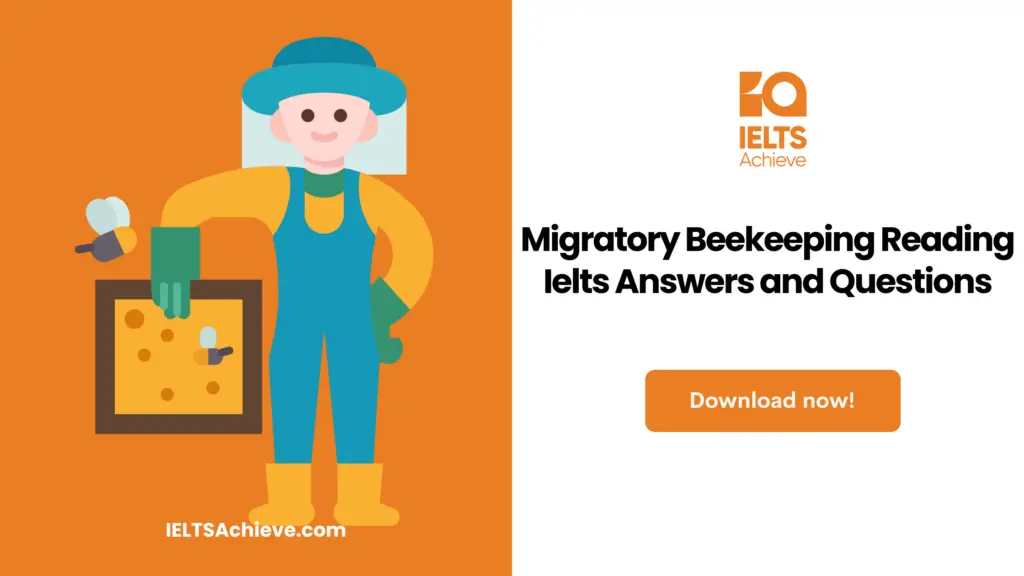The Blog post contains the following IELTS Reading Questions:
- IELTS Reading Yes/No/Not given.
- IELTS Reading Flowchart Completion.
- IELTS Reading Diagram Completion..
Stay informed and prepared for success – Explore our comprehensive Reading Test Info page to get valuable insights, exam format details, and expert tips for mastering the IELTS Reading section.
IELTS Reading Test – Migratory beekeeping

Migratory beekeeping
Taking Wing To eke out a permanent living from their honey bees, about fifty percent of the nation’s 2,000 trade apiarists stop post each spring, wandering north to find more flowers for their bees. Apart from turning floral nectar into honey, these diligent insects also pollinate crops for farmers-for a fee. As autumn approaches, the apiarists pack up their hives and go south to climb for pollination agreements in hot spots like California’s fecund central valley.
Of the 2,000 business apiarists in the United States about half relocate. This pays off in two processes: moving North in the summer and South in the winter lets bees toil lengthy blooming periods, making more honey and money for their custodian. Second, apiarists can transfer their hives to farmers who need bees to breed their crops. Every spring a migrant apiarist in California may transfer up to 160 million bees to flowering fields in Gopher State and every winter his family may drag the hives back to California, where farmers will hire and charge the bees to breed almond and cherry trees.
Migrant beekeeping is nothing new. The early Egyptians moved kaolin hives, doubtless on barges, down the Nile to follow the bloom and nectar flow as it transferred to Cairo. In the 1880s North American apiarists tested with the same plan, moving bees on rafts along the Mississippi and on waterways in Florida, but their lighter, wooden hives kept falling into the water. Other keepers tried the coerce and horse-drawn wagons, but that did not demonstrate practicality. Not up to the 1920s when cars and trucks became affordable and roads improved, did migrant beekeeping begin to take off.
For the Californian apiarist, the breeding period begins in February. At this time, the honeycombs are in specific demand by farmers who have almond copse; they need two hives an acreage. For the three-week-long bloom, apiarists can rent out their hives for $32 each. It’s a windfall for the bees too. Most people contemplate almond honey being excessively bitter to eat so the bees get to retain it for themselves.
By March it is time to transfer the bees. It can take seven nights to pack the 4,000 or so hives that an apiarist may own. These are not transfers in midday because excessively of the bees would end up vagrant. But at night, the hives are piled onto wooden stretchers in sets of four, and raised onto a truck. It is not compulsory to wear gloves or an apiarist’s mask because the hives are not being opened and the bees are almost silent. Just in case some are still lively, bees can be placated with a few gusts of smoke popped into each hive’s tapered entryway.
In their new place, the apiarist will pay the agronomist to allow his bees to feed in such places as an orange copse. The honey manufactured here is scented and sweet and can be sold by the apiarist. To motivate the bees to construct as much honey as possible during this time, the apiarist opens the hives and heaps additional boxes called supers on top. These short-term hive add-on hold frames of vacant comb for the bees to fill with honey. In the offspring hall below, the bees will store honey to eat later. To avert the queen from creeping up to the top and putting down eggs, a screen can be put in the middle of the offspring and the supers. After three weeks the honey can be congregated.
Disgusting scent chemicals are frequently used to irritate bees and drive them down into the hive’s to bottom boxes, leaving the honey-filled supers roughly bee free. These can then be accomplished by the hive. They are massive with honey and might be considered to be 90 pounds each. The supers are taken to the storeroom. In the extracting room, the frames are lilted out and let down into an “unseal” where rotating cutlass shave away the wax that covers all the cell. The unsealed frames are put in a whirligig filled to volume with 72 frames. A switch is overturned and the frames begin to rotate at 300 revolutions per minute; diffusive power throws the honey out of the combs. At last the honey is transferred into barrels for export.
After this, roughly one-fourth of the hives weakened by sickness,mites or a declining or dead queen, will have to be put back. To produce new colonies, a healthy double hive, be full of bees, can be split into two various boxes. One half will hold the queen and a young, earlier breed queen can be put in the other half, to make two hives from one. By the time the flowers bloom, the new queen will be putting down eggs, filling each hive with young toilers bees. The apiarist’s household will then wander with them to their summer place.
Unlock your full potential in the IELTS Reading section – Visit our IELTS Reading Practice Question Answer page now!
Recommended Questions:
Renewable Energy IELTS Reading Question with Answer
Migratory Beekeeping IELTS Reading Answers
Questions 1-7
- The flow chart below outlines the movements of the migratory beekeeper as described in Reading Passage.
- Complete the flowchart.
- Choose your answers from the bottom of the questions and write your answers for the questions 1-7.
Beekeeper Movements
| Example |
| In February, Californian farmers hired bees to help Answer: pollinate almond trees. |
| ↓ |
| In March, beekeepers 1__________ for migration at night when the hives are 2 _______ and the bees are generally tranquil. A little 3________ can ensure that this is the case. |
| ↓ |
| They transport their hives to orange groves where farmers 4_________ beekeepers for placing them on their land. Here the bees make honey. |
| ↓ |
| After three weeks, the supers can be taken to a warehouse where 5_______ are used to remove the wax and extract the honey from the 6_______ |
| ↓ |
| After the honey collection, the old hives are rejected. Good double hives are 7________ and re-queened and the beekeeper transports them to their summer base. |
| List of words/phrases |
| smokebarrelsset offpollinatecombs full | chemicalsprotectionlightmachinesscreenempty | paychargesplitsuperspreparequeens |
Boost your performance in Summary, Notes, Table, and Flowchart Completion tasks. Click here to explore our detailed guide and learn how to effectively complete summaries, notes, tables, and flowcharts in the IELTS Reading section.
Questions 8-11
- Label the diagram below.
- Choose ONE OR TWO WORDS from the Reading Passage for each answer.
- Write your answers for questions 8-11 on your answer sheet
A BEEHIVE

8.
9.
10.
11.
Ready to tackle Diagram Label Completion tasks with confidence? Click here to access our comprehensive guide and learn how to accurately label parts or components of diagrams in the IELTS Reading section.
Questions 12-15
Do the following statements agree with the information given in the Reading Passage? For the questions, 12-15 write.
- YES if the statement agrees with the information given
- NO if the statement contradicts the information given
- NOT GIVEN if there is no information about this
12 The Egyptians keep bees on the banks of the Nile.
13 First attempts at migratory beekeeping in America were unsuccessful.
14 Bees keep honey for themselves in the bottom of the hive.
15 The honey is spun to make it liquid.
Want to excel in identifying the writer’s views and claims? Click here to explore our in-depth guide on how to accurately determine Yes, No, or Not Given in the IELTS Reading section.
Unlock your full potential in the IELTS Reading section – Visit our IELTS Reading Practice Question Answer page now!
Recommended Questions:
Renewable Energy IELTS Reading Question with Answer
Migratory Beekeeping Reading Answers
1. prepare
2. full
3. smoke
4. charge
5. machines
6. combs
7. split
8. (Hexagonal)cells// combs
9. frames(of combs)
10. screen
11. offspring room
12. Not given
13. yes
14. Yes
15. No

We hope you found this post useful in helping you to study for the IELTS Test. If you have any questions please let us know in the comments below or on the Facebook page.
The best way to keep up to date with posts like this is to like us on Facebook, then follow us on Instagram and Pinterest. If you need help preparing for the IELTS Test, join the IELTS Achieve Academy and see how we can assist you to achieve your desired band score. We offer an essay correction service, mock exams and online courses.


